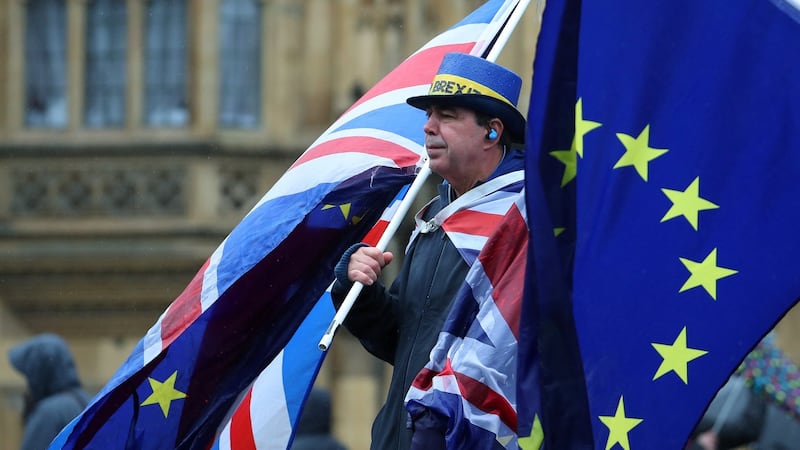The autumn spawning migration of the European eel (s. Anguilla anguilla) to the Sargasso Sea is one of the great animal migrations.
It is an arduous 6,500km journey from Europe’s inland waterways for the seriously endangered species which is threatened by historic overfishing and the degradation and loss of its habitats due to land reclamation, the construction of dams and reductions in water quality.
And now attempts to conserve the Irish branch of the family have been, at the very least, complicated by, of all things, Brexit, their fate tied to the prospects for maintaining a frictionless border between North and South on the Erne river at Ballyshannon.
The protection of the eel is just one of 142 areas of North-South co-operation that are underpinned by joint obligations to EU regulations and to the Belfast Agreement
The decline of eel stocks in Lough Erne, where commercial fishing has been halted, has been attributed in part to the attrition of both elvers entering the river from the Atlantic and of developed silver eels descending from Lough Erne through the turbines of the ESB hydroelectric power station.
The EU requires member states to develop eel management plans and to take measures to ensure that at least 40 per cent of adult eels can escape from inland waters to the sea where they spawn. On the Erne that has meant the seasonal deployment of lorries with aerated water tanks to transport trapped live eels around the turbines.
The protection of the eel is just one of 142 areas of North-South co-operation that are underpinned by joint obligations to EU regulations and to the Belfast Agreement, and which form a key part of the Irish strand of the Brexit discussions.
They are a measure of the complex interdependence of both the cross-Border relationship and the scale and scope of the talks process.
For the most part there is no question of the UK wishing to repudiate any of programmes that range from environmental projects to cross-Border hospitals, but EU negotiators and their UK counterparts have to work on legal language to copperfasten their post-Brexit future.
The eels – provisions for safeguarding the EU’s management plan and regulating the cross-Border transport of live animals – will have their special place in Annex 2.8 of the Irish protocol to the Brexit divorce deal, the Withdrawal Agreement, currently being discussed by the two sides.
Discussions about the controversial Border “backstop” – an agreement would fully align Northern Ireland with the rules of the EU to avoid a hard border – have tended to catch the headlines and eclipse what can seem the more humdrum but nevertheless vital issues.
As the protocol makes clear, however, the range and detail of the discussions is huge – as well as ensuring free trade in goods, the protocol says it shall also “be implemented and applied so as to maintain the necessary conditions for continued North-South co-operation, including in the areas of environment, health, agriculture, transport, education and tourism, as well as energy, telecommunications, broadcasting, inland fisheries, justice and security, higher education and sport”.
Necessity
Guaranteeing many of these, Irish officials stress, is also dependent on unhindered movement across the Border – the necessity for a Border deal permeates the entire protocol.
It also contains provisions to safeguard the Common Travel Area between the Republic of Ireland and the UK, for joint citizenship provisions for Northern Ireland, and to “respect the constitutional status of Northern Ireland and the principle of consent”.
It requires the UK to guarantee that there is “no diminution of rights” caused by its departure from the EU, including in the area of protection against forms of discrimination enshrined in EU law.
The Irish protocol currently runs to eight pages of the 129-page Withdrawal Agreement, which is now being turned into legal treaty language.
The challenge EU leaders have set themselves is to complete broad agreement on the treaty text by June, so that it can be finalised by October and then be put to member states and the European Parliament for ratification ahead of the UK's departure at the end of March, 2019.
The Withdrawal Agreement contains the agreement on transition, or the “implementation period” as the UK calls it, and, like the rest of the text, it stands or falls on agreement on the whole package, including the Irish protocol.
The important parallel discussions now under way on the “future relationship” between the EU and UK, essentially the future trading relationship, are also conditional on no “backsliding” on the agreements made in December in the “Joint Report” between the EU and UK which is reflected in the Withdrawal Agreement.
Brussels and Dublin are adamant that unless the UK honours its commitment to the “backstop” provision of that December agreement, the future relationship talks will stop and the Withdrawal Agreement and the transition deal will be put in jeopardy.
Those talks are set to produce a political outline of a future trading relationship which will be approved with the Withdrawal Agreement, although not having the same legal standing. A trade treaty can be agreed only once the UK is no longer an EU member-state.
The Withdrawal Agreement text is colour-coded to reflect different stages of agreement – currently 15 per cent of the protocol is in green, effectively agreed, 37 per cent remains in yellow, on which there is political agreement on objectives but not on drafting, and 47 per cent is white or uncoloured, unagreed. There is much still to do.
Most of the protocol white text reflects how the EU sees the operation of the “backstop” arrangement – the Border fallback guarantee should the UK prove unable to come up with and agree with the EU-preferred scenario for preventing a hard border.
The Withdrawal Agreement text on safeguarding human rights post-Brexit remains in yellow – the UK is understood to accept in principle that there should be “no diminution of rights, safeguards and equality of opportunity” in the North. However, the language proposed by the commission remains problematic, and the full enumeration of such rights in the annex to the treaty protocol has yet to be agreed.
The range of these rights goes well beyond the issues of discrimination, equality and identity that are traditionally seen as central to the conflict – gender rights legislation, for example, or carers’ rights, or family law arrangements, including custody and maintenance issues, may have their roots in EU legislation.
Although most of such regulations will be incorporated automatically into UK law by means of the European Union (Withdrawal) Bill, campaigners in the North worry over the abandonment by the UK of obligations under the EU's Charter of Fundamental Rights.

“The EU Charter acts as an important constitutional safeguard underpinning human rights protections in Northern Ireland and its removal weakens the quality and range of human rights protections available here,” the Northern Ireland Human Rights Consortium warns.
The EU’s protocol text proposes that “The United Kingdom shall continue to facilitate the related work of the institutions and bodies set up pursuant to the 1998 Agreement, including the Northern Ireland Human Rights Commission, the Equality Commission for Northern Ireland and the Joint Committee of representatives of the Human Rights Commissions of Northern Ireland and Ireland, in upholding human rights and equality standards.”
Irish officials are said to be concerned at the lack of specific commitments to ringfence such funding.
Other non-Border issues such as UK adherence to EU “state aid” rules – to prevent unfair competition through state subsidies – and the challenge of customs-free “transit” for Irish lorries and goods across the UK to EU markets also remain unagreed.
Although not mentioned in the Irish protocol, and in theory an issue for the post-Brexit future relationship talks, because it is an issue of specific concern to Ireland and not other member-states, Irish officials are keen to see the issue taken up in the Irish talks strand.
The UK signalled as far back as last August that it is willing to sign up to membership of the Common Transit Convention to facilitate the transit trade in both directions, and there are precedents using seals on lorries. But there are concerns at how the Irish lorries will be able to bypass potentially long customs queues at ports such as Dover. Transit across Northern Ireland will also require maintaining harmonised transport regulations such as recognition of hauliers’ licences.

















